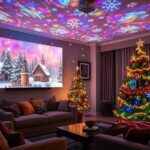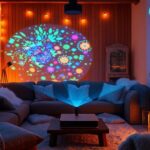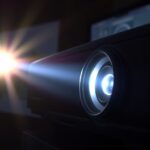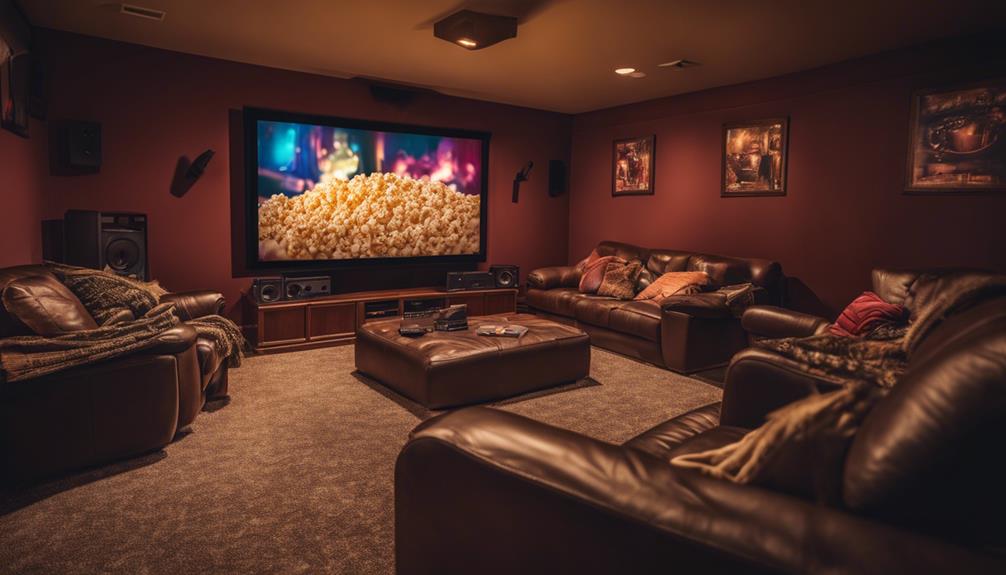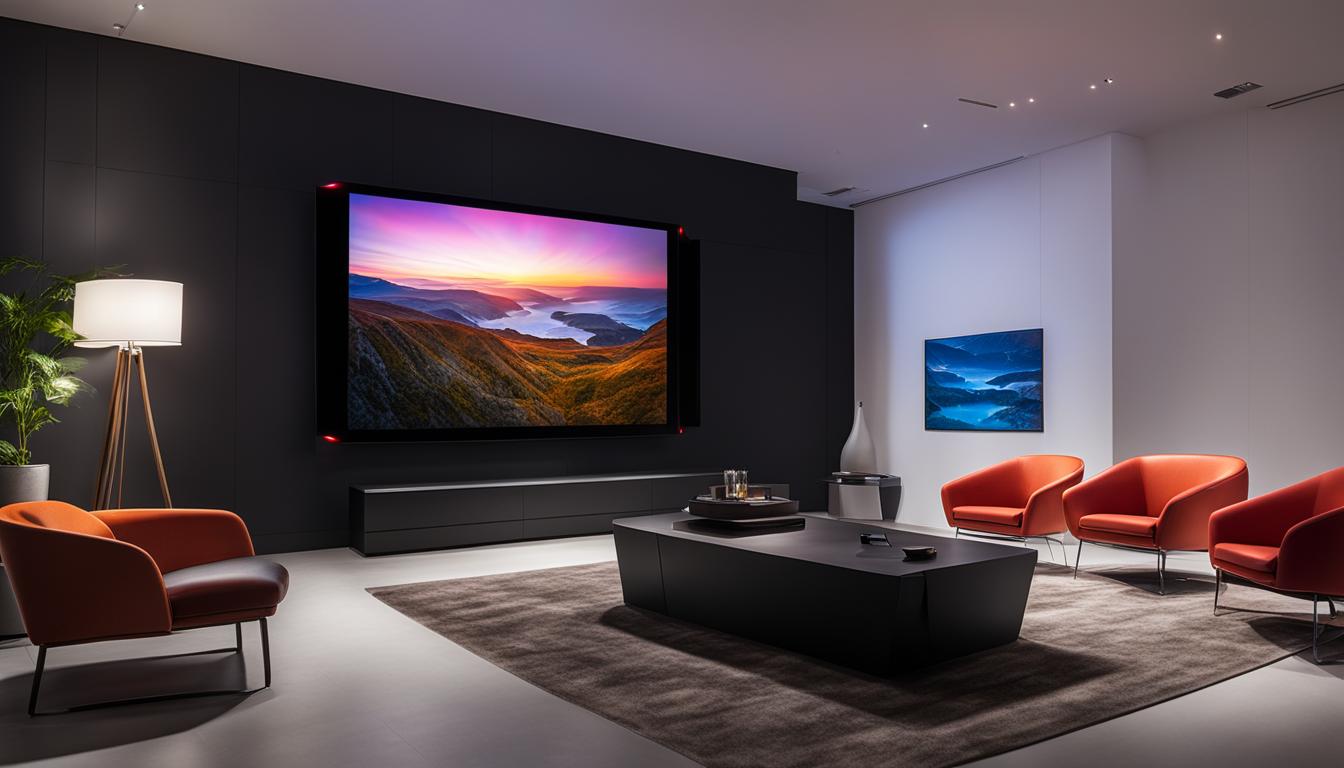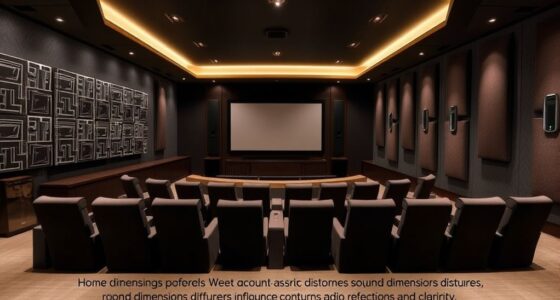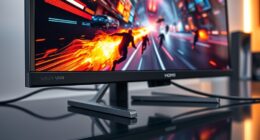You can create a thrilling home haunted house with projector effects that will amaze your guests. Start by choosing a projector with at least 1000 lumens for indoor visibility and a resolution of 1080p for sharp images. Use translucent materials like cheesecloth for clear projections and employ spooky visuals like ghostly figures or animated pumpkins. Add eerie sound effects to heighten the atmosphere. Make the experience interactive with motion-activated props and themed games. Don't forget to maintain safety with fire-resistant decorations and clear pathways. There's much more to explore for perfecting your haunted setup!
Key Takeaways
- Choose a projector with at least 3000 ANSI lumens for outdoor visibility and 1000 lumens for indoor use to ensure clear projections.
- Use Halloween projection screens or translucent materials to enhance clarity and avoid unwanted outlines on dark surfaces.
- Incorporate animated visuals like ghostly figures and synchronized eerie sound effects to create an immersive atmosphere for guests.
- Set up interactive displays and motion-activated props to engage guests and enhance their overall experience during the haunted house event.
- Maintain safety by checking electrical equipment, using fire-resistant materials, and ensuring clear pathways to prevent accidents in low-light conditions.
Projector Selection and Setup

When you're setting up a haunted house, picking the right projector can make all the difference. Start with projector selection, focusing on brightness. For indoor setups, aim for at least 1000 lumens, but if you're going outdoors, you'll want 3000+ ANSI lumens to guarantee your spooky visuals shine through the night.
Additionally, consider the projector's contrast ratio; a higher contrast ratio will yield deeper blacks and brighter whites, enhancing the eerie ambiance of your setup, especially during dark scenes. A projector that supports high refresh rates is beneficial for smooth visuals, particularly when displaying dynamic effects.
Next, consider resolution; a projector with at least 1080p resolution will deliver sharp, clear images that truly enhance the eerie atmosphere. Portability is another essential factor. Choose a lightweight model that's easy to relocate, like a Nebula projector, which offers features such as auto keystone correction for perfect image alignment.
Don't overlook connectivity. Verify your projector has USB or HDMI options for versatile media playback, and wireless capabilities can provide even more flexibility without the hassle of cords.
Before the big night, conduct a test setup in the intended location. Adjust the focus, brightness, and angle, and make sure your audio equipment syncs perfectly with the visuals. This attention to detail will create a fully immersive experience for your guests and elevate your haunted house to the next level!
Essential Materials for Projections

To bring your haunted house projections to life, you'll want to gather essential materials that enhance visibility and impact.
First, invest in a projector with a minimum brightness of 1000 lumens, especially if your display is outdoors. This guarantees your images stand out even in low ambient light.
Next, consider a specialized Halloween projection screen or translucent white materials like cheesecloth. These options boost clarity and create a ghostly effect that adds to your Halloween display.
For ideal image quality, project onto dark, solid surfaces such as light-colored walls or even uncarved pumpkins. These surfaces reduce unwanted outlines and make your projector effects pop.
Additionally, using holographic materials like semi-transparent mesh can create stunning 3D illusions, enriching the depth of your haunted house visuals.
Creative Projection Ideas

To really set the mood in your haunted house, consider projecting ghostly figures across your windows for an eerie effect.
You can also add animated pumpkin faces to your outdoor displays, giving them a playful yet spooky vibe that'll grab the attention of anyone passing by.
These creative projection ideas can transform your space into a thrilling experience for all your guests.
Ghostly Figures Projection
Transform your haunted house experience with enchanting ghostly figures projected across windows, creating an ethereal atmosphere that fascinates guests. Using a projector, you can bring these spooky apparitions to life, especially in dim lighting for maximum impact.
To enhance the visibility and realism of your ghostly projections, consider utilizing lightweight holographic fabric or other translucent materials. Additionally, guarantee that your setup is energy-efficient to avoid excessive energy consumption, much like choosing the best heat pump for your home comfort.
Incorporate animated overlays featuring floating ghosts to add dynamism to your setup. This movement captivates your audience and immerses them in the haunting experience. Position the projector carefully to cover the entire window or projection area, ensuring the ghostly figures blend seamlessly into your haunted house environment.
Don't forget to experiment with eerie sound effects that match the visuals, like ghostly moans and whispers. These sounds will deepen the immersive experience, making your guests feel as if they've stepped into a spectral domain.
Animated Pumpkin Faces
Adding animated pumpkin faces to your haunted house can elevate the spooky atmosphere and delight your guests. You'll need a projector with a minimum brightness of 1000 lumens to guarantee the faces are visible, especially in darker settings.
Using software like AtmosFX, you can easily select from various animated pumpkin designs, showcasing playful or eerie expressions that will thrill your visitors.
To create a mesmerizing display, place your pumpkin on a stable surface. Adjust the projector's focus and angle for the best clarity.
To enhance the immersive experience, consider adding synchronized sound effects that complement the animations, making your setup even more engaging.
Experimenting with different projection materials can take your animated pumpkin faces to the next level. Translucent fabrics or holographic screens can add depth and dynamic effects, making the pumpkin display even more stunning.
By incorporating these elements, you'll guarantee that your haunted house stands out, providing an unforgettable experience for everyone who visits.
Enhancing Atmosphere With Audio

Creating an immersive atmosphere in your haunted house hinges on the effective use of audio elements. Start by incorporating high-quality external speakers to greatly enhance the audio experience. Clear sound effects and chilling music can complement your visual projections, making the scenes come alive.
Leveraging technology advancements, such as those seen in Apple's AI privacy revolution, can also help in optimizing your sound system for a more personalized experience.
Synchronizing audio with your visual effects is vital. Use software that allows for precise timing, ensuring that every creak, whisper, and scream hits just at the right moment to enhance the overall experience.
Don't shy away from experimenting with a variety of sound effects, like creaking doors, ghostly whispers, and eerie background music, to build tension and set the mood.
Consider a surround sound setup to envelop your guests in a more immersive audio environment. This way, every corner of your haunted house feels alive with spooky sounds.
Finally, testing your audio system before the event is essential. Proper volume levels and sound clarity allow you to make adjustments that enhance the impact of your haunted house projections.
With these audio strategies, you'll create an unforgettable experience that keeps guests on edge.
Engaging Guest Experiences

Engaging guests in your haunted house not only heightens the thrill but also deepens their overall experience. You'll want to incorporate various elements that captivate and entertain. Here are three effective approaches:
- Interactive Displays: Use projected animations that guests can engage with, like tapping on screens or participating in themed quizzes. This interaction will create memorable moments and keep them involved.
- Themed Games: Organize scavenger hunts that utilize projections to provide clues and enhance the storytelling. Guests will enjoy exploring while trying to solve puzzles, making them feel part of the narrative.
- Motion-Activated Props: Set up surprises around your haunted house with motion-activated elements that spring to life as guests pass by. This unpredictability adds excitement and keeps guests on their toes.
Additionally, consider hosting a costume contest projected on a big screen. This not only showcases your guests' creativity but also fosters a sense of community and friendly competition.
Safety and Maintenance Tips

Prioritizing safety in your haunted house is essential for guaranteeing a fun and worry-free experience for your guests. Start by using fire-resistant materials for all decorations, including projections. This minimizes fire hazards during your event.
Next, maintain clear pathways throughout the haunted house. This helps prevent tripping hazards, especially in low-light conditions where visibility is limited.
Regularly check all electrical equipment, including projectors and extension cords, to avoid electrical hazards. Make sure everything is secure and functioning properly before the event starts.
If you're using fog machines, guarantee proper ventilation. This prevents any buildup of smoke or fog that could disorient or cause breathing difficulties for your guests.
After the event, perform a thorough inspection of all your equipment, including projectors and cables. This helps you identify any maintenance needs and guarantees everything is in good working condition for future use.
Thematic Decor and Color Schemes

To set the mood in your haunted house, think about how color schemes and thematic decor can pull guests into a spine-chilling experience. A well-chosen color palette can evoke a spooky atmosphere and create an immersive experience.
Consider using black, purple, and orange for a classic Halloween look, while incorporating white and gray for ghostly effects.
Here are three ways to enhance your decor:
- Zone Designation: Divide your haunted house into specific areas, like a creepy entryway or a haunted dining room, to create distinct thematic experiences that guide guests through your story.
- Engaging Props: Utilize props like cobwebs, skeletons, and gravestones to enhance the eerie ambiance. These tactile elements will help guests feel the fright in the air.
- Thematic Accents: Metallic accents in gold or silver can add an elegant touch to your decor, increasing visual interest. Use themed banners and signs throughout your space for narrative context, drawing guests deeper into the haunted house experience.
With these elements, your haunted house will leave a haunting impression.
Frequently Asked Questions
Can I Use My Projector for Halloween Effects?
Yes, you can definitely use your projector for Halloween effects. Just make sure it's bright enough, focus it correctly, and consider using translucent materials for added spookiness. Don't forget to test everything beforehand for the best results!
How Do You Turn Your Home Into a Haunted House?
To transform your home into a spine-chilling wonderland, start by selecting a thrilling theme. Craft eerie pathways, add spooky décor, and sprinkle in some ghostly sounds to enchant and delight your guests' senses.
What Projector for House Mapping?
When choosing a projector for house mapping, you'll want at least 3,000 ANSI lumens for brightness, 1080p resolution for clarity, and short-throw capabilities for smaller spaces. Look for HDMI connectivity and keystone correction features too.
How to Make a Scary Haunted House for Cheap?
Who said scary has to be expensive? You can craft a chilling haunted house using DIY decorations, budget projectors, and community-shared props. Get creative, and watch your frightful vision come alive without emptying your wallet!
Conclusion
By choosing the right projector, designing enchanting visuals, and adding eerie sounds, you can transform your home into a spine-chilling haunted house. Embrace creativity, experiment with themes, and engage your guests for an unforgettable experience. Remember to prioritize safety and keep things well-maintained, ensuring everyone enjoys the fright without worry. So, gather your materials, set the mood, and let your imagination run wild—your haunted house awaits, ready to thrill and chill all who dare to enter!


